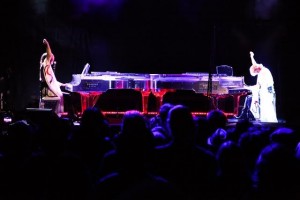aNewDomain.net — Japanese heavy metal star Yoshiki is equally in his element, and equally a star, in the world of classical music. The frontman singer for the band X Japan also happens to be a classical pianist and composer.
On the night of March 14th, 2014, Yoshiki accompanied himself on classical piano at the SXSW Music Festival. But no, he didn’t simply play the piano while singing. Rather, he played against (or next to) himself, to the hoots and hollers of a mesmerized crowd. He accomplished this by utilizing a hologram.

Yoshiki playing with his hologram. Image courtesy: Yoshiki
Manifesting at stage right, the Yoshiki hologram introduced himself and the piece he would be playing — a section from “Art of Life,” the most-popular song by X Japan. The hologram used softly-spoken and almost-shy voice tones. Hologram Yoshiki then sat down and began to play on the right side of a double piano. Less than ten seconds later he was joined from stage left by a live Yoshiki, causing the audience to noticeably become agitated with anticipation. Hologram and live man both played and gesticulated with equal passion and intensity — not to mention quite-similar styles. Check out this video from Yoshiki:
Video courtesy: Yoshiki
As astounding as this may seem, the use of a live person and a dueling hologram on stage is nothing new for Yoshiki. In 2009 X Japan performed a similar feat:
Video courtesy: Naty A. Hayashi
Technically Speaking …
Holograms were conceived of in 1948 but couldn’t actually be made until after the laser was created in 1960.
Holograms are recorded through the process of exposing holographic film — which may be emulsified photographic film or a high-resolution CCD, among other media — simultaneously to a coherent light beam and that beam’s reflection while the scene is being recorded. It is the interference pattern engendered between the coherent light beam and the image that gets recorded, rather than an image of the scene, which is what a normal video recording would capture. Contained in the interference pattern is all of the information within the light field at the sensor. Now, without reading the above-described information again, repeat what you just read, please.
Holograms are played back by reproducing the interference pattern of the original hologram while a coherent light beam — usually of the same wavelength as the original laser illumination source — gets directed onto the pattern isotropically to the original reference beam. This newly reconstructed beam gets diffracted from the interference pattern and with that reproduces the 3D image information of the hologram’s subject matter. What our eyes see is what appears to be a solid image hovering in space.
In order to make an animated, life-like holographic display such as “Second Piano Yoshiki,” it’s necessary to utilize a spatial light modulator (SLM). SLMs are devices that alter the phase or the intensity (or both together) of a light beam.
Yoshiki’s first-ever classical world tour kicks off on April 25th, 2014, in Costa Mesa, California. Let’s see if he conjures up more holographic wonders for the event. To go behind the scenes with this unique composer, check this out:
Image courtesy: Yoshiki
There is nothing cooler than music and technology intersecting to create a spectacle. Enjoy the peaceful, dueling tones of Yoshiki and think — what might you do with a double?
For aNewDomain.net, I’m Brant David.
Based in New Jersey, Brant David is a senior writer for aNewDomain.net. Follow him at +Brant David on Google+ and Brant@aNewDomain.net.














Looks like a basic Pepper’s Ghost illusion, not a hologram to me.